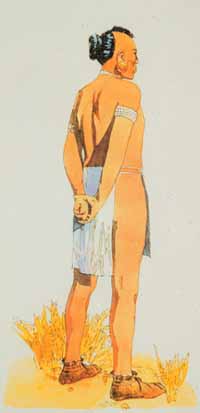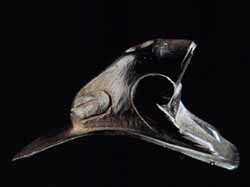
 |
Artist's illustration of a Middle Woodland leader. | |
|
In addition to being respected for their accomplishments and experiences, members of particular Middle and Late Woodland families may have been leaders. |
||
Early Woodland communities in St. Clair County were small and simple, and may have been home to one or two families. There is evidence of seed grinding, tool making, and cooking at these communities, but they do not appear to have been used very long. Larger Early Woodland communities existed along the Illinois River shoreline in Schuyler, Fulton, and Mason counties, but archaeologists have yet to explore these sites in detail.
Middle Woodland communities may have been home to several families, and burial mounds found near by suggest that the settlements were occupied for longer periods of time. Examples of these mounds may be seen two miles north of Kampsville in Calhoun County, at Naples in Scott County, and at the Ogden-Fettie site near Dickson Mounds in Fulton County.
Some archaeologists think the mounds were cemeteries for particular families or clans, although not all Middle Woodland people were buried in mounds. Some have been found buried in villages. Differences in the way a person was buried suggest that some people were more important than others. Perhaps the important people were family or community leaders.
The greater number and size of Late Woodland communities suggest an increase in the Native American population. Archaeologists are especially curious about leadership in societies whose populations are growing. Burial practices often indicate which members of a community were important. Late Woodland burial practices are different than those of the Middle Woodland people, and archaeologists don't yet fully understand why. A clue may be changes in political leadership during the Late Woodland sub-period.
 |
Frog-effigy platform pipe, Liverpool site, Fulton County. | |
|
Middle Woodland people in particular decorated a variety of objects such as pottery and pipes with images of animals. The precise meaning of this practice is not clear to archaeologists, but they provide information about the beliefs of ancient Native Americans. |
||
|
|
Copyright © 2000 Illinois State Museum